Shuncheng Jia
MedKGent: A Large Language Model Agent Framework for Constructing Temporally Evolving Medical Knowledge Graph
Aug 17, 2025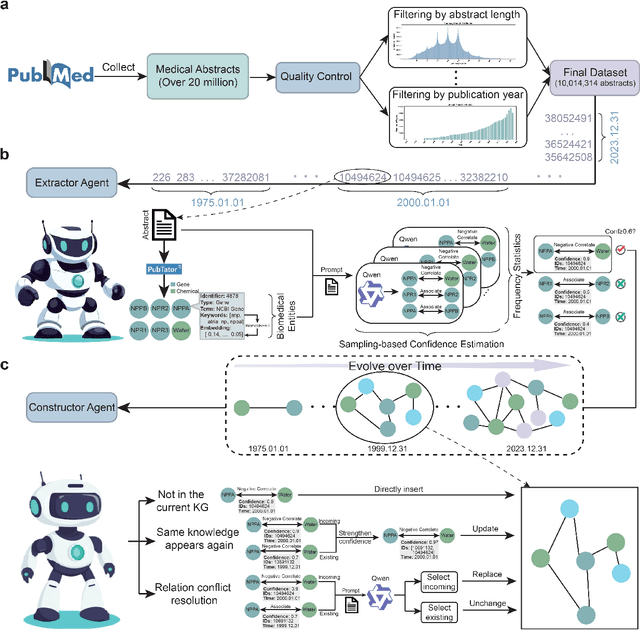
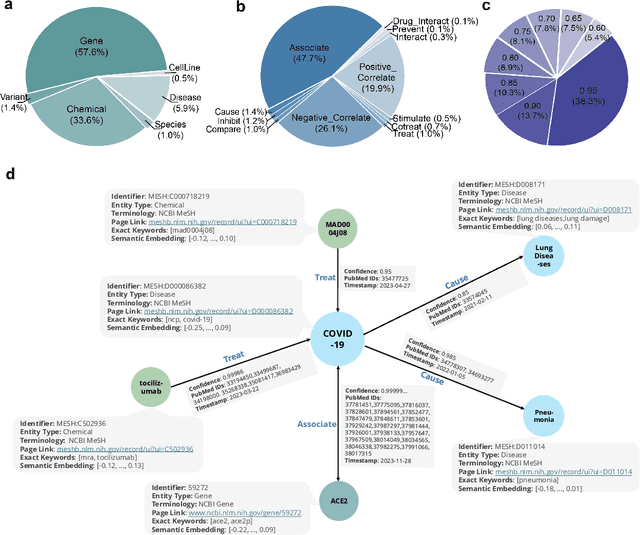
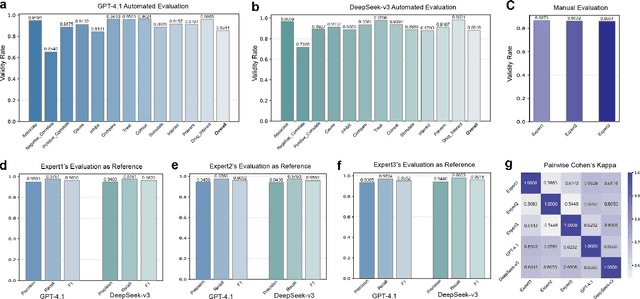
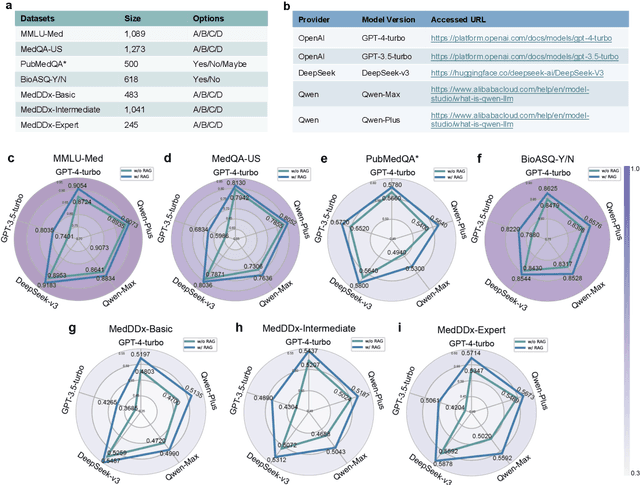
Abstract:The rapid expansion of medical literature presents growing challenges for structuring and integrating domain knowledge at scale. Knowledge Graphs (KGs) offer a promising solution by enabling efficient retrieval, automated reasoning, and knowledge discovery. However, current KG construction methods often rely on supervised pipelines with limited generalizability or naively aggregate outputs from Large Language Models (LLMs), treating biomedical corpora as static and ignoring the temporal dynamics and contextual uncertainty of evolving knowledge. To address these limitations, we introduce MedKGent, a LLM agent framework for constructing temporally evolving medical KGs. Leveraging over 10 million PubMed abstracts published between 1975 and 2023, we simulate the emergence of biomedical knowledge via a fine-grained daily time series. MedKGent incrementally builds the KG in a day-by-day manner using two specialized agents powered by the Qwen2.5-32B-Instruct model. The Extractor Agent identifies knowledge triples and assigns confidence scores via sampling-based estimation, which are used to filter low-confidence extractions and inform downstream processing. The Constructor Agent incrementally integrates the retained triples into a temporally evolving graph, guided by confidence scores and timestamps to reinforce recurring knowledge and resolve conflicts. The resulting KG contains 156,275 entities and 2,971,384 relational triples. Quality assessments by two SOTA LLMs and three domain experts demonstrate an accuracy approaching 90\%, with strong inter-rater agreement. To evaluate downstream utility, we conduct RAG across seven medical question answering benchmarks using five leading LLMs, consistently observing significant improvements over non-augmented baselines. Case studies further demonstrate the KG's value in literature-based drug repurposing via confidence-aware causal inference.
Motif-topology improved Spiking Neural Network for the Cocktail Party Effect and McGurk Effect
Nov 12, 2022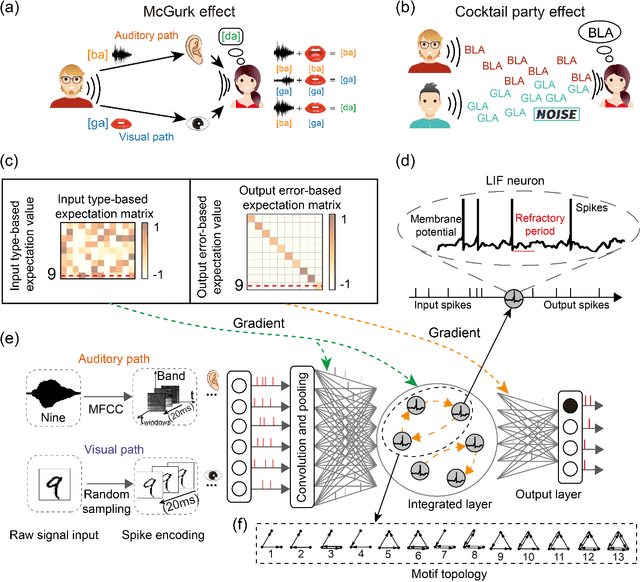
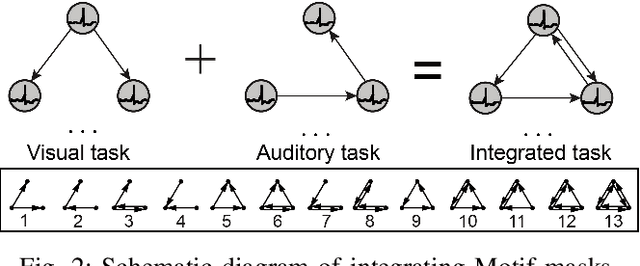
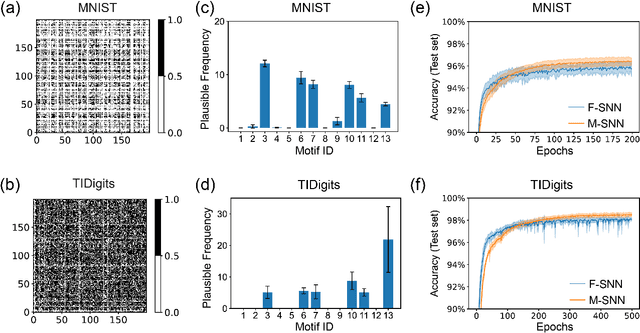
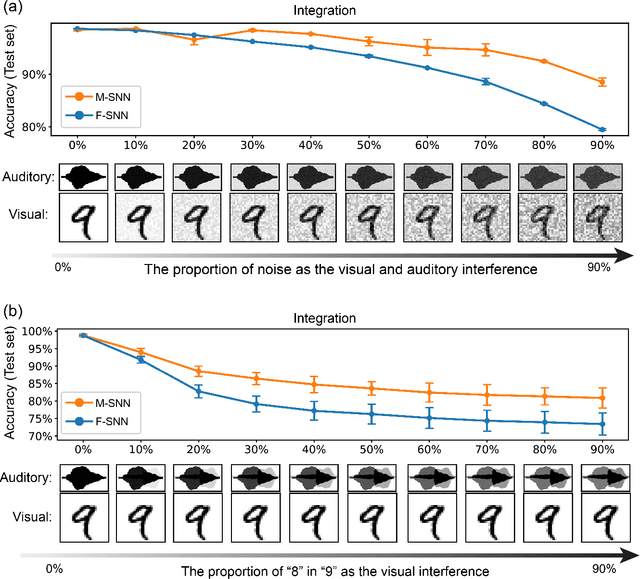
Abstract:Network architectures and learning principles are playing key in forming complex functions in artificial neural networks (ANNs) and spiking neural networks (SNNs). SNNs are considered the new-generation artificial networks by incorporating more biological features than ANNs, including dynamic spiking neurons, functionally specified architectures, and efficient learning paradigms. Network architectures are also considered embodying the function of the network. Here, we propose a Motif-topology improved SNN (M-SNN) for the efficient multi-sensory integration and cognitive phenomenon simulations. The cognitive phenomenon simulation we simulated includes the cocktail party effect and McGurk effect, which are discussed by many researchers. Our M-SNN constituted by the meta operator called network motifs. The source of 3-node network motifs topology from artificial one pre-learned from the spatial or temporal dataset. In the single-sensory classification task, the results showed the accuracy of M-SNN using network motif topologies was higher than the pure feedforward network topology without using them. In the multi-sensory integration task, the performance of M-SNN using artificial network motif was better than the state-of-the-art SNN using BRP (biologically-plausible reward propagation). Furthermore, the M-SNN could better simulate the cocktail party effect and McGurk effect with lower computational cost. We think the artificial network motifs could be considered as some prior knowledge that would contribute to the multi-sensory integration of SNNs and provide more benefits for simulating the cognitive phenomenon.
Motif-topology and Reward-learning improved Spiking Neural Network for Efficient Multi-sensory Integration
Feb 11, 2022

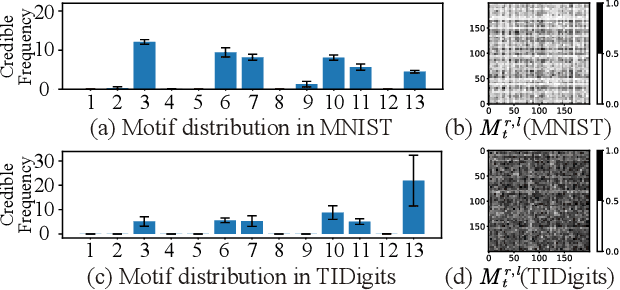

Abstract:Network architectures and learning principles are key in forming complex functions in artificial neural networks (ANNs) and spiking neural networks (SNNs). SNNs are considered the new-generation artificial networks by incorporating more biological features than ANNs, including dynamic spiking neurons, functionally specified architectures, and efficient learning paradigms. In this paper, we propose a Motif-topology and Reward-learning improved SNN (MR-SNN) for efficient multi-sensory integration. MR-SNN contains 13 types of 3-node Motif topologies which are first extracted from independent single-sensory learning paradigms and then integrated for multi-sensory classification. The experimental results showed higher accuracy and stronger robustness of the proposed MR-SNN than other conventional SNNs without using Motifs. Furthermore, the proposed reward learning paradigm was biologically plausible and can better explain the cognitive McGurk effect caused by incongruent visual and auditory sensory signals.
Population-coding and Dynamic-neurons improved Spiking Actor Network for Reinforcement Learning
Jun 23, 2021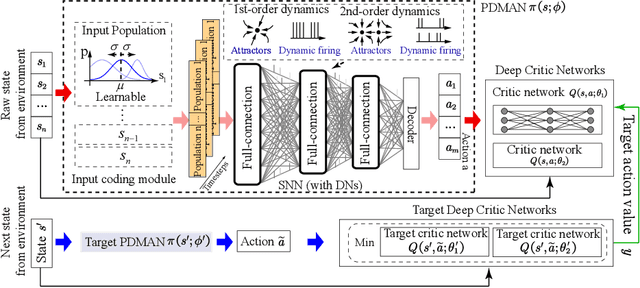
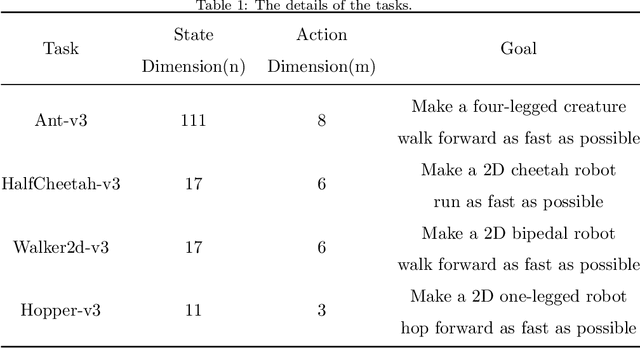
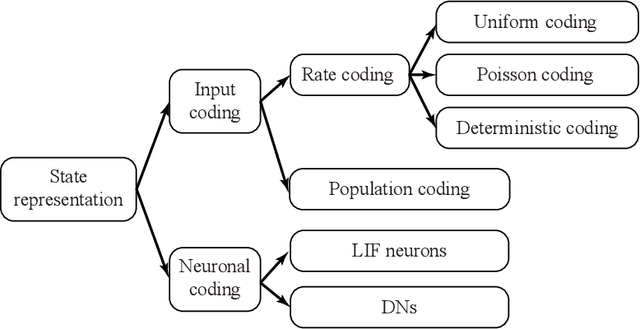
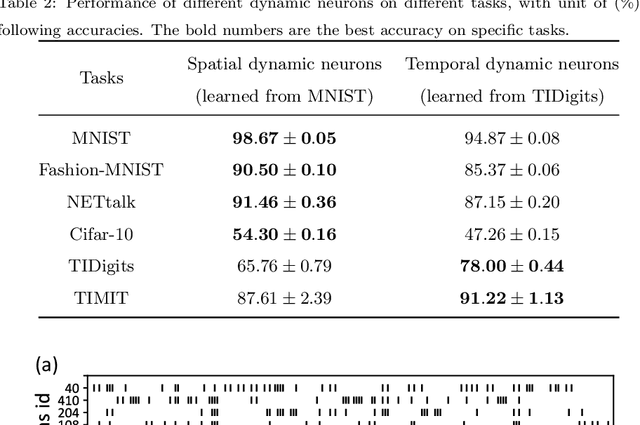
Abstract:With the Deep Neural Networks (DNNs) as a powerful function approximator, Deep Reinforcement Learning (DRL) has been excellently demonstrated on robotic control tasks. Compared to DNNs with vanilla artificial neurons, the biologically plausible Spiking Neural Network (SNN) contains a diverse population of spiking neurons, making it naturally powerful on state representation with spatial and temporal information. Based on a hybrid learning framework, where a spike actor-network infers actions from states and a deep critic network evaluates the actor, we propose a Population-coding and Dynamic-neurons improved Spiking Actor Network (PDSAN) for efficient state representation from two different scales: input coding and neuronal coding. For input coding, we apply population coding with dynamically receptive fields to directly encode each input state component. For neuronal coding, we propose different types of dynamic-neurons (containing 1st-order and 2nd-order neuronal dynamics) to describe much more complex neuronal dynamics. Finally, the PDSAN is trained in conjunction with deep critic networks using the Twin Delayed Deep Deterministic policy gradient algorithm (TD3-PDSAN). Extensive experimental results show that our TD3-PDSAN model achieves better performance than state-of-the-art models on four OpenAI gym benchmark tasks. It is an important attempt to improve RL with SNN towards the effective computation satisfying biological plausibility.
Tuning Convolutional Spiking Neural Network with Biologically-plausible Reward Propagation
Oct 09, 2020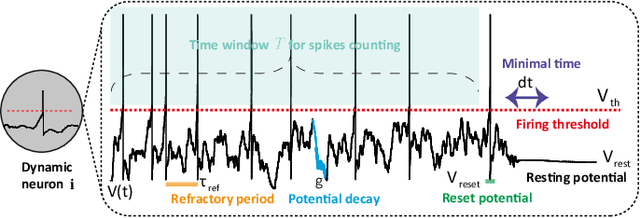
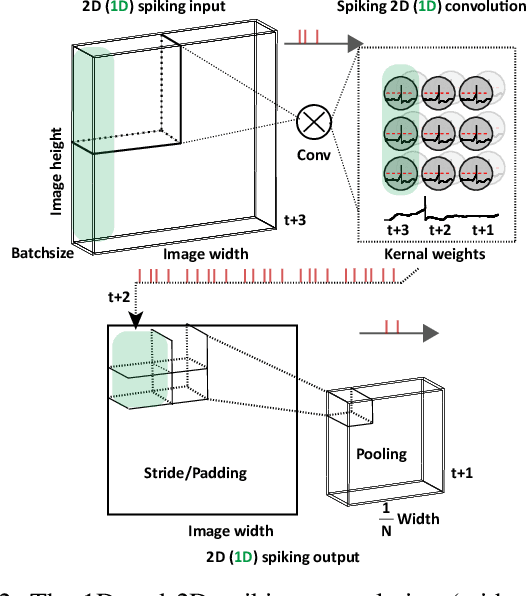
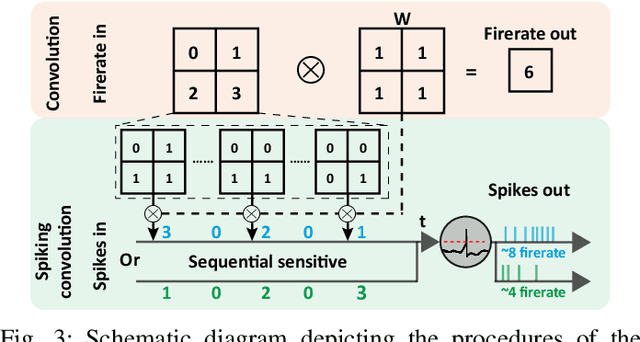
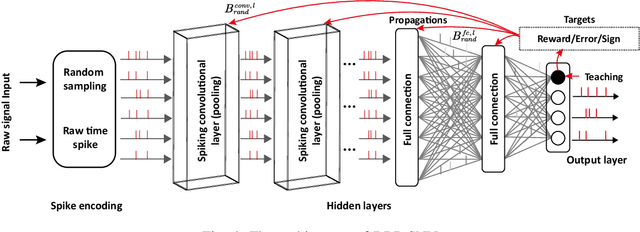
Abstract:Spiking Neural Networks (SNNs) contain more biology-realistic structures and biology-inspired learning principles compared with that in standard Artificial Neural Networks (ANNs). The dynamic neurons in SNNs are non-differential, containing decayed historical states and generating event-based spikes after their states reaching the firing threshold. This dynamic characteristic of SNNs made it hard to be directly trained with standard back propagation (BP) which is considered not biologically plausible. In this paper, a Biologically-plausible Reward Propagation (BRP) algorithm is proposed and applied on a SNN architecture with both spiking-convolution (with both 1D and 2D convolutional kernels) and full-connection layers. Different with standard BP that propagated the error signals from post to pre synaptic neurons layer by layer, the BRP propagated the target labels instead of target errors directly from the output layer to all of the pre hidden layers. This effort was more consistent with the top-down reward-guiding learning in cortical columns of the neocortex. Then synaptic modifications with only local gradient differences were induced with pseudo-BP that might also be replaced with Spike-Timing Dependent Plasticity (STDP). The performance of the proposed BRP-SNN was further verified on spatial (including MNIST and Cifar-10) and temporal (including TIDigits and DvsGesture) tasks. The experimental result showed that the BRP played roles on convergent learning of SNN, reached higher accuracy compared with other state-of-the-art SNN algorithms, and saved more than 50% computational cost compared with that on ANNs. We think the introduction of biologically-plausible learning rules to the training procedure of biologically-realistic SNNs might give us more hints and inspirations towards a better understanding of the intelligent nature of the biological system.
Finite Meta-Dynamic Neurons in Spiking Neural Networks for Spatio-temporal Learning
Oct 07, 2020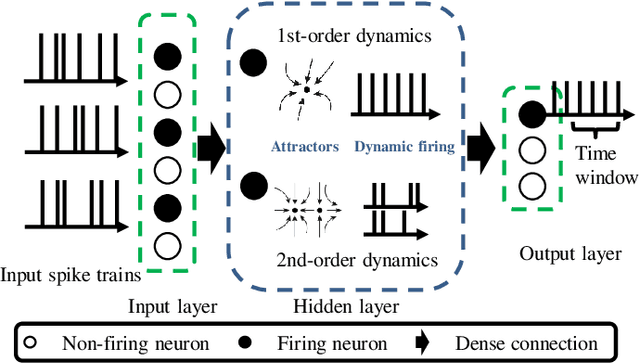
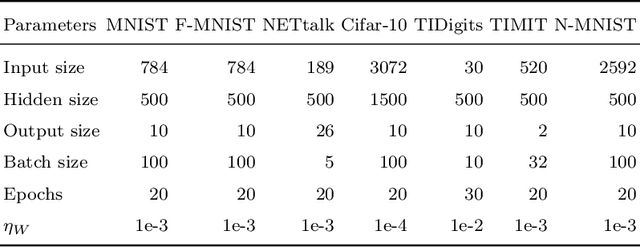
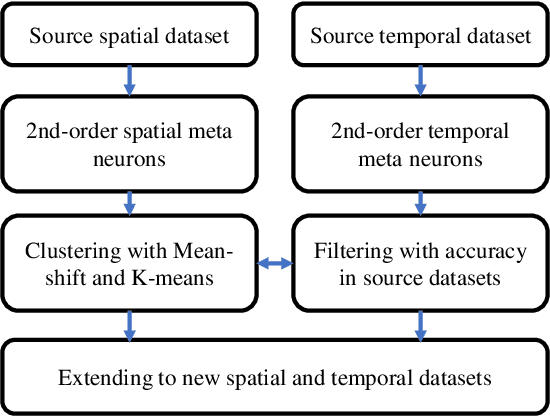
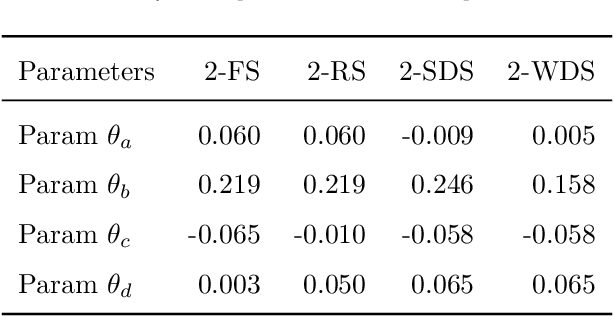
Abstract:Spiking Neural Networks (SNNs) have incorporated more biologically-plausible structures and learning principles, hence are playing critical roles in bridging the gap between artificial and natural neural networks. The spikes are the sparse signals describing the above-threshold event-based firing and under-threshold dynamic computation of membrane potentials, which give us an alternative uniformed and efficient way on both information representation and computation. Inspired from the biological network, where a finite number of meta neurons integrated together for various of cognitive functions, we proposed and constructed Meta-Dynamic Neurons (MDN) to improve SNNs for a better network generalization during spatio-temporal learning. The MDNs are designed with basic neuronal dynamics containing 1st-order and 2nd-order dynamics of membrane potentials, including the spatial and temporal meta types supported by some hyper-parameters. The MDNs generated from a spatial (MNIST) and a temporal (TIDigits) datasets first, and then extended to various other different spatio-temporal tasks (including Fashion-MNIST, NETtalk, Cifar-10, TIMIT and N-MNIST). The comparable accuracy was reached compared to other SOTA SNN algorithms, and a better generalization was also achieved by SNNs using MDNs than that without using MDNs.
 Add to Chrome
Add to Chrome Add to Firefox
Add to Firefox Add to Edge
Add to Edge